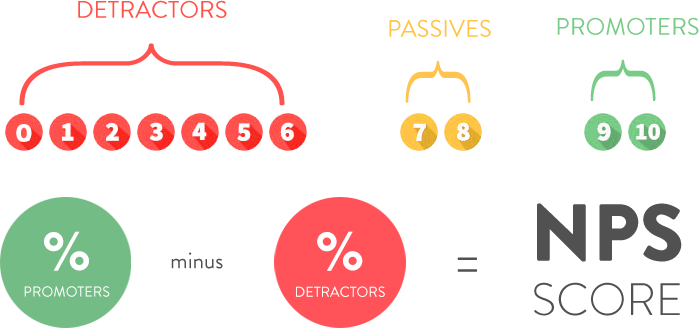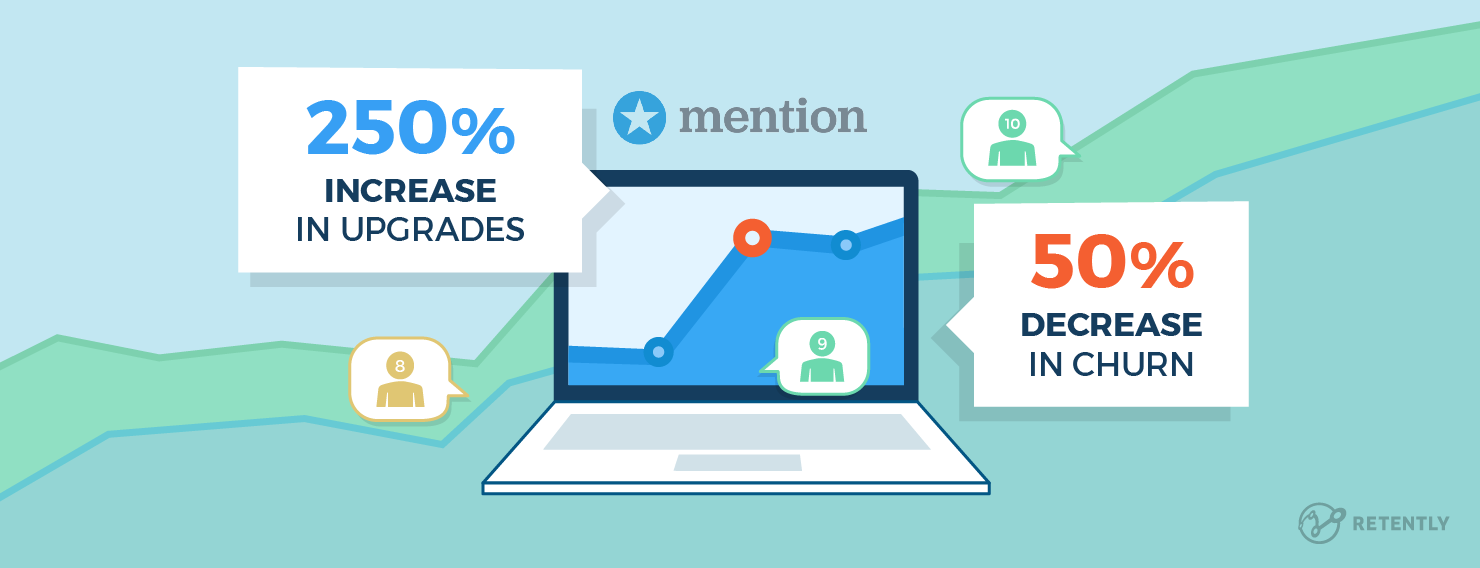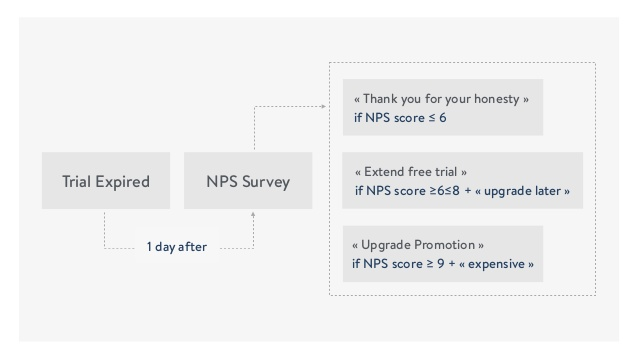How to make NPS work for you

.png)

.png)
Net Promoter Score (NPS) is one of the most helpful tools available for measuring the temperature of your customers. At its core, NPS measures customer satisfaction and collects feedback.
It's sometimes criticized as an oversimplification of user sentiment—but when combined with smart product analytics, segmentation, and targeting, NPS can be a powerful tool for identifying your champion users or, on the flip side, accounts at risk of churn. Used correctly, the Net Promoter Score also provides valuable insights that can be leveraged to make impactful product decisions.
NPS is a very specific kind of survey consists of a single question asking customers how likely they are to recommend a brand, product, or service. Based on the responses, customers are split into 3 groups.

You calculate NPS by subtracting the percentage of promoters from the percentage of detractors. What you're left with is a score that ranges from -100 to +100, which tells you how satisfied customers are and how likely they are to refer you. A good NPS score is 50 or above.
In addition to these scores, many NPS surveys also include a follow-up question. By asking why a customer feels the way they do, businesses get more insight into what they need to work on. For example, you'll find out if the UI is an issue or if process flows don't make sense to customers.
Not everyone sees NPS as a solid metric to base business decisions on. NPS is a basic calculation and some worry doesn't give any valuable, actionable insight. It doesn't give a true indication of what customers are going to do and therefore doesn't influence growth, or so the argument goes.

As one critic points out, NPS doesn't ask customers about their current behaviors. Instead, it asks them to predict some future action that may or may not happen. Life is nuanced and people can't be deciphered based on one fact alone. Put another way:
“NPS isn’t useless, but it can be dangerous because you have one data point. And you think you know your audience because you have a data point, but don’t realize how nuanced their interactions with your company actually are.” – Alex Birkett, former Growth Marketer at CXL
Despite the naysayers, there are lots of situations where NPS can be an extremely effective tool if you know how to use it. If you want to really understand your customers, you shouldn't be using NPS in isolation—it just gets the ball rolling. Instead of using NPS without a plan for customer followup, use it to measure the temperature of your customer cohorts and figure out a way to interact with customers based on their responses.
Let's take a look at how to do that.
There's no silver bullet SaaS metric to help you make all your product decisions. NPS is just one piece of the puzzle. Knowing when to and how to use this metric makes all the difference.
Don't use NPS when you want an exact number of how many people like your product and how many people don't.
The fact is, NPS responses can vary wildly between customer segments. And since many NPS tools don't segment customers for you, it's possible to end up with a long list of NPS results that offer you little to no real insight into what's actually driving responses.
Without defined user cohorts, or cohorts too small for statistical significance, your NPS score alone isn't going to tell you much about user sentiment beyond a ballpark generalization.
You collect a lot of customer data — their preferences, their location, their buying habits and more. Use this information to your advantage and segment customers into groups. For example, if customers are grouped by their buying habits you can use this to target specific groups with NPS.
This way you're not sending email blasts asking the same people the same question repeatedly. Stagger your survey and analyze each group separately.
For people who buy frequently or have a more comprehensive subscription package, use an in-app survey while they're in your app using it.
With this approach, customers are more likely to respond and give honest and thoughtful feedback. Consider setting it up to only trigger for certain customer groups at a time. For example, when they log into their account, confirm their group and then show the survey.
You can also use NPS across the customer journey. From onboarding to activation to retention, NPS will help you guide your customers through the process. NPS is a simple way to quickly evaluate which customers are at risk of churning. And once you’ve identified people who might be unhappy enough to go elsewhere, you can reach out to try and keep them around.
Include an open field that allows users to provide additional details about why they gave the score they did. You can uncover all kinds of important insights this way.
Avoid using NPS too early in the user journey. You need to let customers get to know you a bit before you ask that big of a question. Do consider sending an NPS survey at multiple points in the user lifecycle, though. People can have different opinions at different times.
In-app NPS surveys typically get more traction because they ask the question in the right context, while customers are engaged with your product. Just be careful to place the survey in a non-intrusive way so that you aren’t inhibiting user tasks. You can also use a combination of an in-app survey followed by an email version for users who don’t respond.
Customer onboarding is a huge part of what makes your product successful and determines whether or not customers will stay or go. Get onboarding right early on, and you have a better chance of retaining more customers over time.
You can use NPS to figure out what separates the customers who cancel from those who upgrade and make an impact on your conversion rate. Run a survey immediately after the end of a customer's trial period and ask the ones who churn how they felt about the service. Depending on the bucket they fall into, you can take a number of actions. Here's how Mention approached this situation and increased their conversion rate.
After free trials ended, Mention realized that they had no insight into what made some customers stay and others leave. They used NPS surveys to get qualitative feedback from customers right when their trial was set to expire. This way, Mention got real-time insights that they could turn into action. The goal for Mention wasn't to see what score customers gave them. They wanted to use “NPS insights to reduce customer churn and boost revenue.”

This approach worked really well for Mention because once they had the survey responses, they segmented customers based on their score: promoters, passives and detractors. Using NPS for segmentation proved to be a powerful tactic because, at the end of the exercise, Mention was able to send targeted and relevant emails to each group:

The best chance Mention had to retain customers was to offer specific value to passives and promoters. These groups were more likely to be receptive to a little extra effort and attention to convert and buy.
NPS worked in this scenario because Mention knew which customers to target and offered each group value. In the end, customers got a meaningful experience out of it and could probably say that it was somewhat of a turning point for them. These customers could have walked away but the extra effort on Mention's part kept them engaged. Customers were encouraged to buy a package and, by doing so, Mention got a revenue boost.
Activation is the second most important part of a customer's journey. This is your chance to make sure that their first few days using your product are their best. Activation affects your growth potential further down the funnel because the sooner a customer understands and appreciates what you offer, the longer they'll stay a customer.
NPS is a great tool to help move customers to activation. If you compare your NPS survey responses with customers' actual behavior in your product, you can start to understand what behaviors separate your promoters from your detractors.
Sachin Rekhi, a product marketer, ran an experiment and found that there is a correlation between “specific behavior within the product to NPS results (logins, searches, profile views, and more).” He also found “a strong correlation between certain product actions and a higher NPS.”
The takeaway here is that when you find your product's “aha moment” — the point where customers experience the promised value for the first time — you know when activation happens. So instead of focusing on detractors and trying to turn them into promoters, focus instead on getting promoters to the aha moment.
Look at all the major actions customers can take in your product — upload content, add to their contact list, write a review — and compare whether these actions correlate to NPS. For example, let's compare two customers. One uploads content within a few days of using your product and the other one doesn't do anything. Send them both an NPS survey to see if the customer who uploaded content has a higher score. If it's higher, send NPS surveys to a larger sample and if results show that uploading content always equals a higher NPS score, you've found a correlation.
Now the focus is making sure that you can get as many customers as possible to upload content.
In order to drive retention, reach out to customers based on their response. I'm not talking about their score; this is just the first step in the conversation. What I'm referring to is the conversation you have with customers after the NPS survey.
Ondrej Sedlacek, co-founder of SatisMeter, explains it this way:
“NPS is not about the score itself. It is about listening to your customers and helping them solve their problems. It is often overlooked to follow up immediately on every response. You can resolve unsatisfied customers' problems and effectively reduce their churn with NPS.”
Even though the survey takes a few seconds for a customer to complete, take a moment to tell them that their input is valuable to you and it's all part of making the product better. Getting feedback is especially important if you've uncovered serious issues. Follow-up gives you a chance to connect with customers to improve the relationship and retention.
Write up some unique and relevant follow-up messages that address the needs of each group. For example, ask detractors to share more information about their experience. This approach has three main benefits. You can:
The goal here is to use the qualitative data you collect to not only improve your product and retention but also to cater your communication to the needs of each NPS group.
NPS is a very helpful tool; you just have to be clear on when to use it to get the most out of it. This way, the information you get is meaningful and offers real insights you can work with.
Plus, it's not all about the number you get when you run the calculation. It's more about how you take that information to cater to the specific needs of each customer.